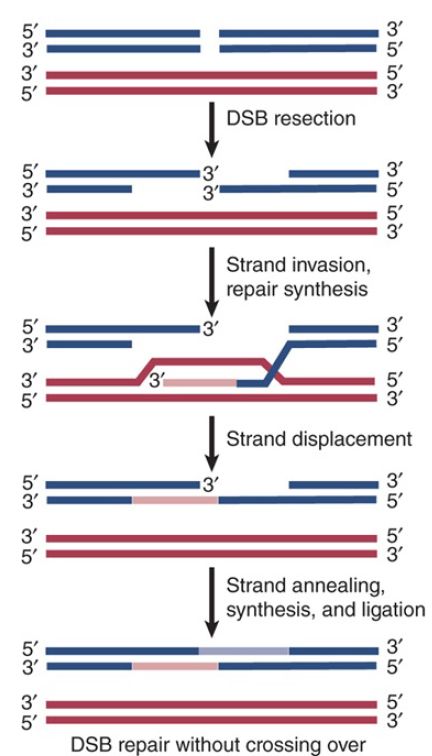
The Synthesis-Dependent Strand-Annealing Model
 المؤلف:
JOCELYN E. KREBS, ELLIOTT S. GOLDSTEIN and STEPHEN T. KILPATRICK
المؤلف:
JOCELYN E. KREBS, ELLIOTT S. GOLDSTEIN and STEPHEN T. KILPATRICK
 المصدر:
LEWIN’S GENES XII
المصدر:
LEWIN’S GENES XII
 الجزء والصفحة:
الجزء والصفحة:
 14-4-2021
14-4-2021
 2796
2796
The Synthesis-Dependent Strand-Annealing Model
KEY CONCEPT
The synthesis-dependent strand-annealing (SDSA) model is relevant for mitotic recombination because it produces gene conversions from double-strand breaks without associated crossovers.
The DSBR model accounts for meiotic homologous recombination that gives crossover products, but it cannot explain all homologous recombination because mitotic gene conversions are typically not accompanied by crossing over. The synthesis-dependent strandannealing (SDSA) model serves as a better model for what occurs during mitotic homologous recombination in which DSB repair events and gene conversion are not associated with crossing over.
Studies of the DSB that occurs during mating-type switching events in yeast led to the development of SDSA as a model for mitotic recombination.
The synthesis-dependent strand-annealing pathway, shown in FIGURE 1, is initiated in a mechanism similar to the DSBR model in that DSBs are processed by 5′-end resection. Following strand invasion and DNA synthesis, the second end is not captured as it is in the DSBR model. In the SDSA model, the invading strand, which contains newly synthesized DNA identical in sequence to the strand it displaced, is itself displaced. Following displacement, theinvading strand rea nneals with the other end of the DSB. This is followed by synthesis and ligation to repair the DSB. In this model, the break is repaired using the homologous sequence as a template, but does not involve crossing over. This feature of the SDSA model makes it suitable for mitotic gene conversions for which there is no associated crossing over. The SDSA pathway is also responsible for recombination without crossover in the first phase of meiosis .

FIGURE 1 The synthesis-dependent strand-annealing (SDSA) model of homologous recombination. Recombination is initiated by a double-strand break and is followed by end processing to form single-strand tails with 3′–OH ends. Strand invasion and DNA synthesis repair one strand of the break. Instead of second-strand capture , the strand in the D-loop is displaced. The single strand can anneal with the single strand of the other end. Repair synthesis then completes the double-strand break repair process. No Holliday junction is formed, and the product is always noncrossover.
 الاكثر قراءة في مواضيع عامة في الاحياء الجزيئي
الاكثر قراءة في مواضيع عامة في الاحياء الجزيئي
 اخر الاخبار
اخر الاخبار
اخبار العتبة العباسية المقدسة


